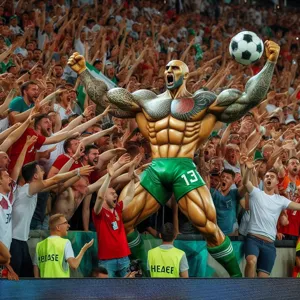In an era where borders are increasingly blurred and cultures intertwine, few phenomena embody the spirit of globalization as vividly as soccer.
Known as “the beautiful game,” soccer transcends geographical boundaries and unites millions across continents, forging connections that go beyond mere athletic competition. From the bustling streets of Rio de Janeiro to the historic pitches of London, the sport thrives in diverse environments, shaped by the influences of global media, international transfers, and cross-cultural collaboration. This blog post delves into the profound relationship between globalization and soccer, exploring how this universal passion has been molded by technological advancements, economic shifts, and social dynamics. Join us as we uncover the ways in which the world’s game reflects and shapes our interconnected planet, celebrating the rich tapestry of cultures, players, and fans that make soccer a truly global phenomenon.
1. Introduction to Globalization and Soccer

Soccer, often hailed as the world’s game, is a vibrant tapestry woven with the threads of globalization. As we traverse the globe, from the bustling streets of Rio de Janeiro to the serene fields of rural Africa, the impact of a connected planet on this beloved sport becomes strikingly clear. Globalization has transcended borders, bringing together diverse cultures, styles, and talents into a singular, dynamic arena where soccer is not just played but celebrated.
In this interconnected world, the exchange of ideas, practices, and philosophies has revolutionized how soccer is perceived and enjoyed. Players from various backgrounds now converge in leagues far from their home countries, showcasing their skills and enriching the game with a blend of techniques and strategies. This cross-pollination has birthed a new era of soccer, where the artistry of Brazilian flair meets the disciplined precision of German tactics, creating a thrilling spectacle for fans worldwide.
Moreover, globalization extends beyond the players to the very fabric of the sport itself. Major tournaments, like the FIFA World Cup and UEFA Champions League, draw in vast international audiences, reflecting the global passion for the game. The rise of digital media has allowed fans to engage with their favorite teams and players in real-time, regardless of geographic barriers. Social media platforms, online streaming, and mobile applications have further intensified this connection, enabling supporters to unite over shared love for soccer even when separated by thousands of miles.
As we delve deeper into the relationship between globalization and soccer, we will explore how this phenomenon shapes the sport’s identity, influences its growth, and fosters a sense of community among fans around the world. Through this exploration, it becomes evident that soccer is more than just a game; it is a powerful symbol of unity, transcending cultural divides and bringing people together in a way that few other activities can. Welcome to a journey that celebrates the beautiful game in all its global glory.
2. The Historical Context of Globalization in Sports
To truly understand the impact of globalization on soccer, it’s essential to delve into the historical context that has shaped the sport as we know it today. Soccer, or football as it is known in most parts of the world, has roots that trace back to ancient civilizations, but its modern form began to take shape in the 19th century in England. The establishment of standardized rules and the formation of clubs marked the beginning of soccer as an organized sport. However, it wasn’t until the advent of international competitions, such as the FIFA World Cup, that soccer began to transcend national boundaries.
The early 20th century saw the first wave of globalization in sports, propelled by technological advancements in transportation and communication. The proliferation of railways and steamships made it easier for teams to travel internationally, while the invention of radio and, later, television brought live matches into homes around the world. This newfound accessibility sparked interest and participation in soccer beyond its European origins, particularly in South America, Africa, and Asia.
The post-World War II era marked a significant turning point. As nations rebuilt and sought to establish their identities, soccer served as a unifying force. The establishment of FIFA as a global governing body in 1904 laid the groundwork for international diplomacy through sport. The introduction of the World Cup in 1930 not only showcased national pride but also fostered a sense of global community among fans. Countries that had once been rivals found common ground in their passion for the game, paving the way for a more interconnected soccer culture.
However, the true explosion of globalization in soccer occurred in the late 20th century with the rise of commercialism and the advent of satellite television. The sport became a lucrative business, attracting sponsors and investors from around the globe. Major clubs began to recruit players from diverse backgrounds, leading to a melting pot of talent on the field. This influx of international players not only elevated the standard of play but also brought various cultural influences into the game, enriching the soccer landscape.
As we navigate the complexities of the 21st century, the historical context of globalization in soccer reminds us that the sport is not just a game; it is a dynamic tapestry woven from the threads of culture, identity, and commerce. Understanding this history is crucial for appreciating how globalization continues to shape soccer today, influencing everything from player transfers to fan engagement. As we explore the modern implications of globalization in the world of soccer, we see how the past lays the foundation for the future of this beloved sport.
3. The Rise of Global Soccer Leagues

The rise of global soccer leagues has transformed the beautiful game into a truly international spectacle, breaking down geographical barriers and uniting fans from every corner of the globe. Once dominated by local clubs and national leagues, the soccer landscape has evolved dramatically in the wake of globalization, giving birth to prominent leagues that attract top talent and massive audiences worldwide.
Leagues such as the English Premier League, La Liga in Spain, and Serie A in Italy have emerged as powerhouses, showcasing some of the best players from diverse backgrounds. These leagues are no longer just about regional pride; they have become melting pots of cultures, where fans can witness a rich tapestry of playing styles and philosophies, all competing on the same pitch. The influx of international stars brings with it a blend of techniques, strategies, and flair that enhances the overall quality of the game, making it more exciting and unpredictable.
Moreover, the appeal of these leagues extends far beyond the stadiums. With the advent of digital streaming platforms and social media, fans from different continents can watch matches live, engage with their favorite players, and participate in discussions about tactics and performances in real time. This connectivity fosters a sense of community among supporters who might never have the chance to attend a game in person.
The financial implications of this globalization are also significant. Top clubs are now able to tap into lucrative broadcasting deals, sponsorship opportunities, and merchandise sales that extend their reach beyond their home countries. As clubs strive for competitive advantage, investments in youth academies and scouting networks have become essential, creating pathways for emerging talent worldwide. This not only enhances the quality of players but also ensures that leagues remain vibrant and competitive.
In essence, the rise of global soccer leagues exemplifies how globalization has reshaped the game, creating a dynamic ecosystem where local passion meets global ambition. As soccer continues to evolve, it will be fascinating to see how these leagues adapt to the changing landscapes of fan engagement, marketing, and player development, ensuring that the world game remains as captivating as ever.
4. The Influence of International Player Transfers
The landscape of soccer has been profoundly transformed by the globalization of player transfers, reshaping not only teams but also the very fabric of the game itself. In an era where talent knows no borders, clubs around the world are continuously scouting for the next big star, often overlooking geographic limitations. This cross-pollination of skills and styles has given rise to a more dynamic and diverse playing field.
The influence of international player transfers extends beyond mere talent acquisition; it reflects a broader trend of cultural exchange. When a player moves from one country to another, they bring with them unique techniques, training methodologies, and tactical perspectives. For instance, the arrival of South American flair in European leagues has ignited a passion for skillful dribbling and creative plays, while African players have introduced a new level of athleticism and resilience. This melting pot of influences has enriched the game, fostering a style that is more vibrant and unpredictable.
Moreover, the transfer market has become a bustling economic ecosystem, with clubs investing millions to secure top talent. The financial implications of these transfers ripple through leagues, affecting everything from player salaries to club revenues. Teams that successfully navigate this global market often find themselves reaping the rewards of not just on-field success, but also increased visibility and commercial opportunities. Sponsorship deals, merchandise sales, and fan engagement soar when clubs can showcase international stars, turning local teams into global brands.
However, this globalization comes with its challenges. The significant influx of foreign players can sometimes lead to tensions within teams and fan bases. Questions about national identity and loyalty arise as clubs prioritize international talent over homegrown players. Yet, amidst these complexities, the beauty of soccer remains: it is a sport that thrives on connection, unity, and the celebration of diversity. The influence of international player transfers is a testament to how a globally interconnected world can shape the beautiful game, making it a true reflection of our shared humanity.
5. How Technology Connects Fans Worldwide

In today’s digital age, technology has revolutionized the way soccer fans connect with their beloved sport, transcending geographical boundaries and creating a global community. Gone are the days when following a team meant being confined to the local stadium or tuning into a regional broadcast. Now, with just a smartphone or computer, fans can access live matches, highlights, and commentary from anywhere in the world.
Streaming services and social media platforms have become vital conduits for connecting fans with the action on the pitch. Major leagues like the Premier League, La Liga, and Serie A embrace this trend by offering live streaming options and on-demand content, ensuring that supporters can watch their teams compete in real time, regardless of their location. For instance, a fan in Tokyo can cheer for their favorite London club while viewing the game alongside thousands of others in real-time through social media interactions.
Moreover, social media has transformed the way fans engage with each other and their teams. Platforms like Twitter and Instagram allow fans to share their thoughts, experiences, and emotions surrounding matches, creating a vibrant online dialogue. Teams and players utilize these channels to reach out directly to their supporters, sharing behind-the-scenes content, personal stories, and exclusive insights that foster a deeper connection. This interaction not only strengthens the bond between clubs and fans but also unites individuals from diverse backgrounds, all rallying behind a common passion.
Additionally, technology has enabled fans to participate in the global soccer conversation through podcasts, blogs, and fan forums. These platforms empower individuals to share their perspectives, analyze games, and discuss tactics, contributing to a richer understanding of the sport. As a result, soccer enthusiasts can engage with a variety of viewpoints, enriching their experience and deepening their appreciation for the game.
Ultimately, technology has not just changed how we watch soccer; it has fundamentally redefined what it means to be a fan in today’s interconnected world. As the sport continues to evolve, the threads of technology and globalization will weave an even tighter fabric, ensuring that the beautiful game remains a shared experience for millions across the globe.
6. The Role of Major Tournaments in Promoting Global Unity
Major soccer tournaments, such as the FIFA World Cup and continental championships like the UEFA European Championship, serve as monumental platforms that transcend borders and unite nations through the universal language of sport. These events are not just about competition; they are grand celebrations of culture, passion, and shared human experiences. Fans from diverse backgrounds come together in stadiums and living rooms alike, rallying behind their teams with fervor that ignites national pride.
The World Cup, held every four years, showcases not only the world’s top talent but also the diverse styles of play that exist across continents. From the samba flair of Brazil to the tactical discipline of Germany, each team brings its unique identity to the pitch, creating a vibrant tapestry that reflects global diversity. The tournament fosters a sense of camaraderie among nations, as fans engage in friendly banter, share in the highs of victory, and commiserate over defeats.
Moreover, these tournaments often spark dialogues about social issues, highlighting themes such as equality, inclusion, and environmental sustainability. Initiatives aimed at promoting gender equality in sports, for instance, gain momentum during these high-profile events, encouraging a collective movement towards a more equitable world. The visibility that comes with major tournaments allows for impactful conversations around pressing global matters, ultimately fostering a sense of unity beyond the confines of the game.
Additionally, the economic impact of these events can be profound, as host countries see an influx of visitors and global attention, generating opportunities for cultural exchange and mutual understanding. The shared excitement and unpredictability of the matches create bonds that can last long after the final whistle, reminding us that despite our differences, the love for soccer can unite us all. In essence, major tournaments are a microcosm of globalization, illustrating how the world game not only reflects our interconnectedness but also actively shapes it, one match at a time.
7. Cultural Exchange Through Soccer

Cultural exchange through soccer is one of the most vibrant and enriching aspects of the sport, showcasing how the beautiful game transcends borders and fosters connections across diverse communities. As soccer gains global traction, it becomes a powerful medium for sharing traditions, values, and lifestyles, creating a tapestry of cultural interactions that enrich both the players and the fans.
Take, for instance, the influx of international players in domestic leagues. When a Brazilian star dazzles on the pitch in England, or a Japanese midfielder showcases their skills in Spain, they bring with them unique playing styles, training techniques, and a wealth of cultural heritage. Fans are not just spectators; they engage with these athletes’ backgrounds, learning about their countries, customs, and culinary delights, which are often celebrated through themed events and match-day experiences.
Additionally, global tournaments like the FIFA World Cup serve as melting pots of culture, where nations come together, each proudly representing their identity. The stadiums become vibrant showcases of flags, traditional attire, and shared rituals, as supporters from all corners of the globe unite in their love for the game. These moments foster a sense of community and understanding, breaking down stereotypes and building friendships that extend beyond the sport.
Moreover, grassroots initiatives and programs using soccer as a tool for social change further amplify cultural exchange. Organizations around the world leverage the sport to promote inclusivity, gender equality, and education, often bringing together children from various backgrounds to play together. These interactions not only teach essential life skills but also celebrate diversity, allowing young players to form bonds and learn from each other’s cultures in a shared love for the game.
In essence, soccer acts as a bridge that connects us, facilitating a rich exchange of ideas and traditions. As fans and players alike immerse themselves in the global soccer community, they find common ground in their passion for the sport, making the world feel a little smaller and more interconnected. Soccer is not just a game; it is a cultural phenomenon that fosters understanding and appreciation across the globe, proving that in the end, we are all part of one collective team.
8. Economic Impacts of Globalization on Local Clubs
Globalization has transformed soccer from a localized pastime into a global phenomenon, significantly impacting local clubs in ways that are both profound and multifaceted. Economically, the influx of global capital and sponsorship deals has allowed clubs to enhance their financial capabilities, but this has also led to disparities that can undermine local traditions and identities.
For many local clubs, globalization offers access to a broader audience and increased revenue streams. Merchandising, broadcasting rights, and international sponsorships have become essential lifelines. Clubs can now sell jerseys and memorabilia not just in their home cities but also to fans across continents, amplifying their brand recognition and financial stability. This has allowed smaller clubs to dream bigger, investing in better facilities, training regimes, and youth academies, thereby elevating the overall quality of the game.
However, the economic impacts of globalization are not all positive. The pressure to compete on a global scale can strain local clubs, especially those that lack the financial backing of wealthy owners or extensive media exposure. As larger clubs dominate the market, often hoarding talent and resources, smaller clubs may struggle to retain their local players, who are increasingly lured by the promise of higher wages and greater exposure at bigger teams. This talent drain can diminish the competitive spirit of local leagues and erode the community ties that are often the heart of these clubs.
Furthermore, the globalized nature of soccer can lead to a homogenization of playing styles and club cultures. As clubs increasingly adopt similar marketing strategies and player recruitment tactics, the unique characteristics that once defined local teams can become diluted. Fans may find themselves cheering for a brand rather than a community, resulting in a loss of the emotional connection that has historically fueled local support.
In navigating the complexities of globalization, local clubs must find a balance between embracing new opportunities and preserving their unique identities. By leveraging global connections while staying true to their roots, they can thrive in this interconnected world, ensuring that the essence of local soccer remains vibrant amid the sweeping changes of the global game.
9. Social Media and Its Effect on Fan Engagement
In the digital age, social media has revolutionized the way fans engage with soccer, transforming the sport into a truly global phenomenon. Platforms such as Twitter, Instagram, Facebook, and TikTok have bridged the gap between players, clubs, and supporters, creating a vibrant online community that transcends geographical boundaries. Fans can now follow their favorite teams and players in real-time, receiving instant updates, behind-the-scenes content, and exclusive insights that were once reserved for only a select few.
The impact of social media on fan engagement is profound. Clubs leverage these platforms to connect with their supporters, disseminating content that resonates with their local and international audiences. Whether it’s a heartfelt message from a player after a match, a live Q&A session, or interactive polls that invite fans to voice their opinions, social media has made it possible for clubs to cultivate a deeper sense of community. This unprecedented level of interaction fosters loyalty and encourages fans to remain invested in their teams, even across vast distances.
Moreover, the ability for fans to share their experiences—whether through posts, comments, or videos—creates a dynamic and participatory culture. Match days have transformed into social media events, with fans posting live updates, sharing their thoughts during games, and showcasing their match-day rituals with hashtags that amplify their voices. This digital camaraderie not only enhances the match-day experience but also connects supporters from different cultures, uniting them through their shared passion for the game.
However, social media’s influence extends beyond mere engagement; it also plays a critical role in shaping narratives around the sport. The rapid spread of information means that player transfers, injuries, and match analyses are discussed and dissected at lightning speed, often before official announcements are made. This can create a sense of urgency and excitement, but it can also lead to misinformation and heightened tensions among fans.
In this interconnected world, clubs that harness the power of social media effectively will not only enhance their brand but also create a loyal fan base that transcends borders. As globalization continues to shape the landscape of soccer, understanding and leveraging social media’s potential will be essential for clubs aiming to thrive in this new era of fan engagement.
10. Globalization’s Impact on Youth Development Programs
Globalization has reshaped the landscape of youth development programs in soccer, creating a more interconnected and competitive environment for aspiring athletes around the globe. With the rise of digital communication and international outreach, young players now have unprecedented access to training resources, coaching expertise, and competitive opportunities that were once limited to local or regional contexts.
In this new era, soccer academies are no longer confined by geographical boundaries. Talented youth can showcase their abilities through online platforms, attracting the attention of scouts from elite clubs across continents. Programs that used to operate in isolation are now collaborating internationally, sharing best practices and innovative training techniques that enhance the development of young players.
For instance, clubs like FC Barcelona and Manchester City have established academies worldwide, leveraging their brand recognition to identify and nurture talent in various countries. These programs not only provide high-quality coaching but also offer young athletes the chance to learn from a diverse array of soccer philosophies and styles. This exposure broadens their understanding of the game and equips them with a versatile skill set that is crucial in today’s fast-paced soccer landscape.
Moreover, globalization has facilitated the exchange of ideas and strategies among coaches and trainers from different cultures, enriching youth development programs with a wealth of knowledge. This cross-pollination of soccer techniques allows for the emergence of innovative training methods that adapt to the evolving demands of the sport.
However, the impact of globalization is not without its challenges. The increasing pressure to perform can lead to burnout among young players, while the commercialization of youth soccer raises concerns about access and equity. As clubs seek to identify the next generation of stars, it becomes essential to balance the competitive drive with the well-being and holistic development of young athletes.
In conclusion, globalization has undeniably transformed youth development programs in soccer, opening doors for aspiring players while also presenting new challenges. As the world becomes more interconnected, the future of youth soccer hinges on the ability of these programs to adapt, innovate, and prioritize the welfare of the players they aim to cultivate.
11. Challenges Faced by Local Leagues in a Global Market
As soccer continues to thrive on a global scale, local leagues find themselves navigating a complex landscape filled with both opportunities and challenges. One of the most pressing issues is the overwhelming influence of international leagues, particularly those in Europe, which attract top talent and massive broadcasting deals. As fans increasingly tune in to watch marquee matches from around the world, local leagues struggle to maintain their fanbases, often resulting in dwindling attendance and reduced merchandise sales.
Moreover, the financial disparity exacerbates this challenge. While European clubs rake in substantial revenues from sponsorships and global partnerships, many local leagues operate on shoestring budgets. This financial imbalance makes it difficult for smaller clubs to compete for talent, as they cannot match the salaries offered by wealthier teams. Consequently, local leagues often lose their star players to bigger clubs, further diminishing the quality of play and drawing fans away.
The proliferation of digital platforms and streaming services has also transformed how soccer is consumed. While this offers local leagues a chance to reach broader audiences, it simultaneously means they are competing for attention in a crowded marketplace filled with high-profile matches. Fans now have access to a smorgasbord of soccer content, leading to fragmented viewership and loyalty that can shift with the click of a button.
Additionally, the cultural significance of local leagues can be overshadowed by the glitz and glamour of international competitions. Traditional rivalries and community ties that once defined local clubs may wane as the allure of following a club with global appeal becomes irresistible. This shift poses a risk to the very identity of local leagues, raising questions about their long-term viability in an increasingly interconnected world.
In this era of globalization, local leagues must adapt to survive. Innovative marketing strategies, community engagement initiatives, and partnerships with international entities can help bridge the gap, allowing them to cultivate a loyal fan base while celebrating the unique culture and history that make them special. How local leagues navigate these challenges will ultimately determine their place in the global soccer landscape.
12. The Future of Soccer in an Increasingly Connected World
As we look to the future of soccer in an increasingly connected world, the game is poised to undergo transformative changes that will redefine its landscape. The rise of technology and digital communication is already reshaping how fans engage with their favorite teams, players, and competitions. From virtual reality experiences that allow fans to feel like they are on the pitch to interactive apps that provide real-time statistics, the way we consume soccer is evolving rapidly.
Moreover, globalization has led to a more diverse and inclusive sport, where players from various cultural backgrounds bring their unique styles and tactics to the game. This melting pot of talent not only enriches the playing experience but also broadens the appeal of soccer across different regions, making it a truly global phenomenon.
As clubs and leagues increasingly tap into international markets, the financial dynamics of the sport are also changing. Sponsorship deals, merchandise sales, and broadcasting rights are no longer confined to local or national audiences; they extend across continents. This shift not only enhances the financial stability of clubs but also allows them to invest more in grassroots programs, nurturing the next generation of soccer stars around the world.
However, with these opportunities come challenges. The pressure to perform on a global stage can lead to heightened expectations for teams and players alike. The demands of constant travel, media scrutiny, and fan engagement can affect player well-being and performance. As we move forward, striking a balance between global outreach and maintaining the integrity of the sport will be crucial.
In essence, the future of soccer lies in embracing this interconnectedness while staying true to the values that have made the game beloved worldwide. As fans, players, and organizations navigate this new era, the beautiful game will continue to evolve, reflecting the rich tapestry of cultures and communities that make soccer not just a sport, but a shared passion that unites us all.
13. Case Studies: Success Stories of Global Soccer Brands
### Case Studies: Success Stories of Global Soccer Brands
In the ever-evolving landscape of global soccer, several brands have emerged as shining examples of how to effectively harness the power of globalization to elevate their status, expand their reach, and connect with passionate fans around the world. These success stories illustrate not only the commercial potential of soccer but also how cultural ties and community engagement can drive brand loyalty.
One standout example is **Nike**, which has expertly positioned itself at the forefront of the soccer apparel and equipment market. Their innovative marketing campaigns, such as the “Just Do It” slogan, and partnerships with globally recognized athletes like Cristiano Ronaldo and Neymar have allowed them to transcend geographical boundaries. By creating localized content that resonates with diverse audiences—from flashy ads featuring local players to grassroots initiatives that promote youth soccer—Nike has successfully cultivated a deep emotional connection with fans. Their collaboration with clubs and national teams has further solidified their presence, making them synonymous with the sport itself.
Another compelling case study is **Adidas**. With its long-standing history in soccer, Adidas has leveraged its heritage to create a brand narrative that appeals to both tradition and innovation. Their iconic three-stripe branding is instantly recognizable, but it’s their strategic partnerships with clubs like Real Madrid and Manchester United that have propelled them to the forefront of the global market. Adidas has also embraced technology, introducing smart soccer balls and performance-enhancing gear that appeal to tech-savvy players and fans alike. Their commitment to sustainability, as seen in initiatives to create eco-friendly products, has further endeared them to a socially conscious audience.
**FC Barcelona**, a club known for its rich history and commitment to community, presents another fascinating example. By developing a global fan base through strategic international tours and engaging digital content, the club has successfully transformed its local identity into a worldwide phenomenon. Their partnership with global brands like Rakuten has not only enhanced their financial standing but also expanded their reach into new markets, especially in Asia. Barcelona’s focus on grassroots development through their La Masia academy has also allowed the club to cultivate local talent while simultaneously enhancing their global reputation.
These case studies highlight the dynamic interplay between globalization and soccer branding. By leveraging cultural narratives, innovative marketing strategies, and a commitment to community engagement, these brands have not only achieved commercial success but have also played a pivotal role in shaping the global soccer landscape. As the world becomes increasingly interconnected, the opportunities for soccer brands to resonate with fans across borders are limitless, and those that adapt and innovate will undoubtedly thrive in this global arena.
14. Conclusion: Balancing Tradition and Modernity in Soccer
As we draw the curtain on our exploration of globalization’s impact on soccer, it becomes evident that the beautiful game stands at a fascinating crossroads between tradition and modernity. The surge in global connectivity has ushered in an era where cultural exchanges, technological advancements, and economic forces converge to reshape how the sport is played, consumed, and celebrated.
While the influx of international talent enriches leagues and diversifies playing styles, it also raises critical questions about the preservation of local identities and grassroots connections. The passion of local fans, the legacy of historic clubs, and the age-old rivalries that define soccer’s very spirit must be carefully safeguarded amid the relentless march of commercialization and global branding.
Moreover, as digital platforms provide unprecedented access to matches and highlight reels, the game has morphed into a 24/7 spectacle that transcends borders. However, this accessibility should not dilute the essence of what makes soccer special—the community it fosters, the cultural narratives it weaves, and the joy it brings to millions around the globe.
The challenge for stakeholders, from governing bodies to club owners and fans alike, is to strike a delicate balance. By honoring the traditions that have shaped soccer into the world’s most beloved sport while embracing the innovations that enhance its reach and engagement, we can ensure that the game remains vibrant, inclusive, and true to its roots. In a world that grows ever more interconnected, soccer has the unique opportunity to unite diverse cultures and foster understanding, reminding us all of our shared love for this extraordinary game.
15. Call to Action: Embracing Globalization for the Future of the Game
As we stand at the crossroads of tradition and modernity, the call to action is clear: embracing globalization is not just a choice; it’s a necessity for the future of soccer. The game we love is evolving, and with it comes an opportunity to foster inclusivity, creativity, and innovation. To fully harness the potential of a connected planet, we must champion the diverse voices and cultures that enrich the sport.
Imagine a world where soccer transcends borders, uniting fans from different backgrounds and creating a vibrant tapestry of shared experiences. This vision can be realized through collaborative initiatives that celebrate local talents while promoting global exchanges. By investing in youth academies that welcome aspiring players from all corners of the globe, we can cultivate a new generation of soccer stars, each bringing their unique flair to the pitch.
Moreover, clubs and organizations should actively seek partnerships across continents, creating pipelines for talent scouting and training programs. Such collaborations can enhance the quality of play, as clubs learn from one another, adopting best practices and strategies that reflect a rich blend of styles. The global soccer community will benefit immensely from these exchanges, fostering a spirit of camaraderie and respect among fans and players alike.
As fans, we have a role to play too. By supporting initiatives that promote diversity and inclusion in soccer, we can ensure that the beautiful game continues to be a source of joy, inspiration, and unity. Attend games that showcase international competitions, engage with various soccer cultures, and advocate for policies that prioritize accessibility in sports.
In conclusion, let us embrace globalization as a powerful force that can propel soccer into a future filled with possibility. By championing inclusivity and collaboration, we can ensure that this beloved sport not only survives but thrives in an interconnected world, enriching lives and building bridges across nations. The future of soccer is bright, and together, we can shape it into a game that truly reflects the beauty of our global community.
As we conclude our exploration of globalization and its profound impact on soccer, it’s clear that this beautiful game transcends borders, cultures, and languages, uniting people around a shared passion. The interconnectedness of our world has not only transformed how the game is played and consumed but has also fostered a rich tapestry of diversity that enhances the sport at every level. From the rise of international leagues to the blending of styles and talents, soccer continues to evolve in ways that reflect our global society. As fans, players, and stakeholders, we have the opportunity to celebrate this evolution while advocating for inclusivity and sustainability in the sport. As we look to the future, let us embrace the idea that soccer is not just a game; it is a powerful force for connection and understanding in an ever-changing world. Thank you for joining us on this journey through the world of soccer shaped by globalization, and we can’t wait to see how this dynamic relationship continues to unfold on the pitch!




































